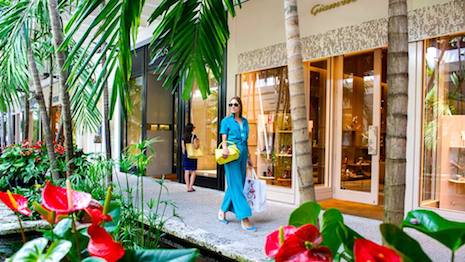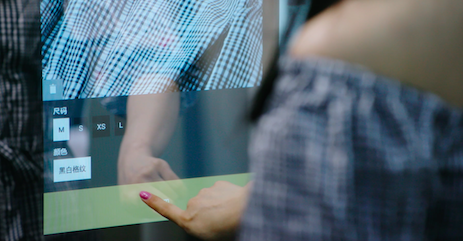 Retailers must adapt both their physical hubs to meet shoppers' expectations. Image credit: Bal Harbour Shops
Retailers must adapt both their physical hubs to meet shoppers' expectations. Image credit: Bal Harbour Shops
While digital influences up to 75 percent of all in-store visits, retailers have not been keeping pace with shoppers’ preferences, according to a new Boston Retail Partners report.
The consultancy's "Retail’s Digital Crossroads" report examines how retailers who are quick to adjust to today’s non-linear, multichannel shopping journeys will attract more customers. Although retailers have been investing in the digital shopping experience, not all of these investments reflect consumers’ preferences.
“While we have intuitively known that digital had become such a pervasive element of the overall shopping experience, it was surprising to quantitatively validate how much it influences in-store consumer behavior and purchases,” said Ryan Grogman, senior vice president and practice lead at BRP, Boston. “Consumers spend a considerable amount of time researching products, checking reviews, validating inventory availability and comparing prices before they even visit a store.”
The report is based on surveys of 1,212 retail consumers and 60 retail executives in the United States. Among the shoppers surveyed, there was a 50/50 gender split and Generation Z, millennials, Generation X and baby boomers were about equally represented.
Digital investments
Bricks-and-motar stores are not disappearing at the rates once feared by retailers, but brands must still adapt both their physical and digital hubs to meet the expectations of tech-savvy shoppers from all generations.
Before shoppers head to stores, they tend to go online to compare prices, check inventory and purchase items for in-store pickup. Retailers, however, have devoted resources to building store locators, virtual shopping lists and enabling social sharing of products — features that shoppers seldom use.
 Digital influences up to 75 percent of all in-store visits. Image credit: Pinterest
While shopping in-store, 46 percent of all consumers across all generational age groups use their mobile devices to compare prices, check inventory and read product reviews.
Considering nearly half of all shoppers surveyed use mobile devices in-store, it is unsurprising that a majority, 59 percent, value retailers who offer customer Wi-Fi networks. However, only 47 percent of retailers offer that feature.
“Once in the store, digital content continues to influence [consumers'] experiences through additional product and price comparisons and ratings research, but also by offering shoppers the ability to look up retailer-specific coupons and offers,” Mr. Grogman said.
Digital influences up to 75 percent of all in-store visits. Image credit: Pinterest
While shopping in-store, 46 percent of all consumers across all generational age groups use their mobile devices to compare prices, check inventory and read product reviews.
Considering nearly half of all shoppers surveyed use mobile devices in-store, it is unsurprising that a majority, 59 percent, value retailers who offer customer Wi-Fi networks. However, only 47 percent of retailers offer that feature.
“Once in the store, digital content continues to influence [consumers'] experiences through additional product and price comparisons and ratings research, but also by offering shoppers the ability to look up retailer-specific coupons and offers,” Mr. Grogman said.
 Smart mirrors and interactive kiosks are growing in popularity. Image credit: Alibaba
Other in-demand in-store features include augmented or virtual reality experiences, self-checkout, interactive kiosks and payment via mobile apps or virtual wallets.
Retailers cite budget concerns as a major roadblock in improving their retail technology. BRP finds that reinventing stores and improving digital services help retain customers and draw new shoppers away from competitors.
Luxury challenges
Investing in the technology that consumers are clamoring for not only improves customer service, but it also can provide retailers more information about their customers.
“As consumer shopping habits change, luxury retailers especially need to keep a pulse on their customers’ preferences and enhance the shopping experience through the implementation of new technologies,” BRP's Mr. Grogman said. “It is equally important to know what will turn off your customers or what they don’t feel is as important."
Luxury consumers are increasingly using digital channels within their purchase paths, with a mere 22 percent starting and ending their journey offline.
Ecommerce sales of luxury goods are growing rapidly. Today, online sales of personal luxury goods are $20 billion, making up 8 percent of total luxury sales. By 2025, McKinsey projects this figure will more than triple to $74 billion, with about one in five luxury sales happening online (see story).
"Luxury retailers must not continue to simply be reactive to these changes in consumer habits," Mr. Grogman said. "They must be more proactive and think several years into the future to anticipate the ideal customer experience, as some changes may take a few years to implement.”
Smart mirrors and interactive kiosks are growing in popularity. Image credit: Alibaba
Other in-demand in-store features include augmented or virtual reality experiences, self-checkout, interactive kiosks and payment via mobile apps or virtual wallets.
Retailers cite budget concerns as a major roadblock in improving their retail technology. BRP finds that reinventing stores and improving digital services help retain customers and draw new shoppers away from competitors.
Luxury challenges
Investing in the technology that consumers are clamoring for not only improves customer service, but it also can provide retailers more information about their customers.
“As consumer shopping habits change, luxury retailers especially need to keep a pulse on their customers’ preferences and enhance the shopping experience through the implementation of new technologies,” BRP's Mr. Grogman said. “It is equally important to know what will turn off your customers or what they don’t feel is as important."
Luxury consumers are increasingly using digital channels within their purchase paths, with a mere 22 percent starting and ending their journey offline.
Ecommerce sales of luxury goods are growing rapidly. Today, online sales of personal luxury goods are $20 billion, making up 8 percent of total luxury sales. By 2025, McKinsey projects this figure will more than triple to $74 billion, with about one in five luxury sales happening online (see story).
"Luxury retailers must not continue to simply be reactive to these changes in consumer habits," Mr. Grogman said. "They must be more proactive and think several years into the future to anticipate the ideal customer experience, as some changes may take a few years to implement.”
